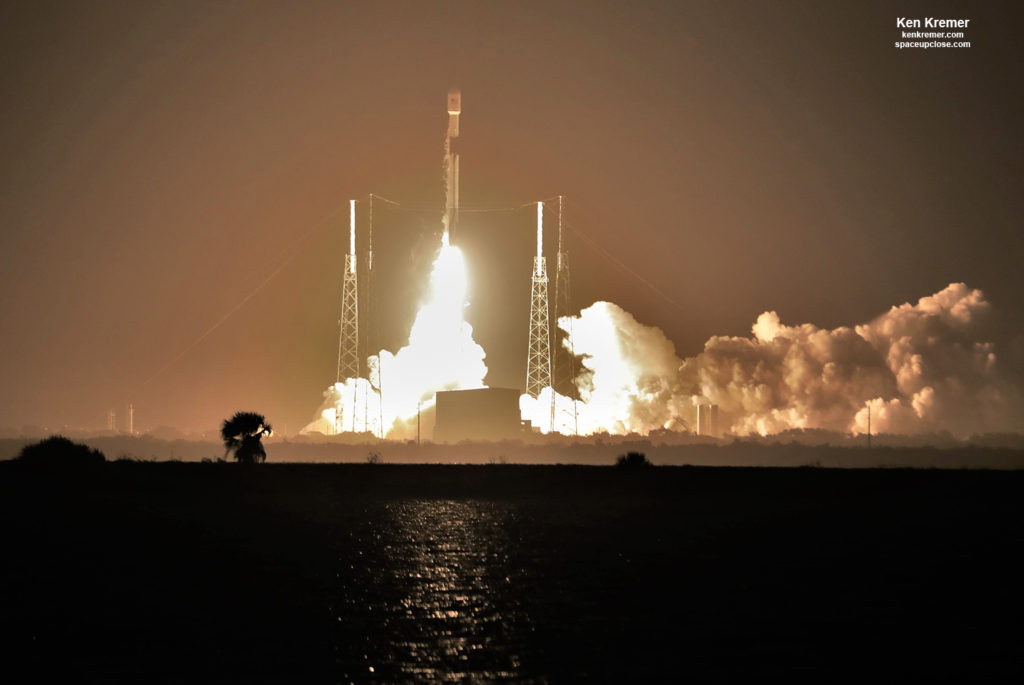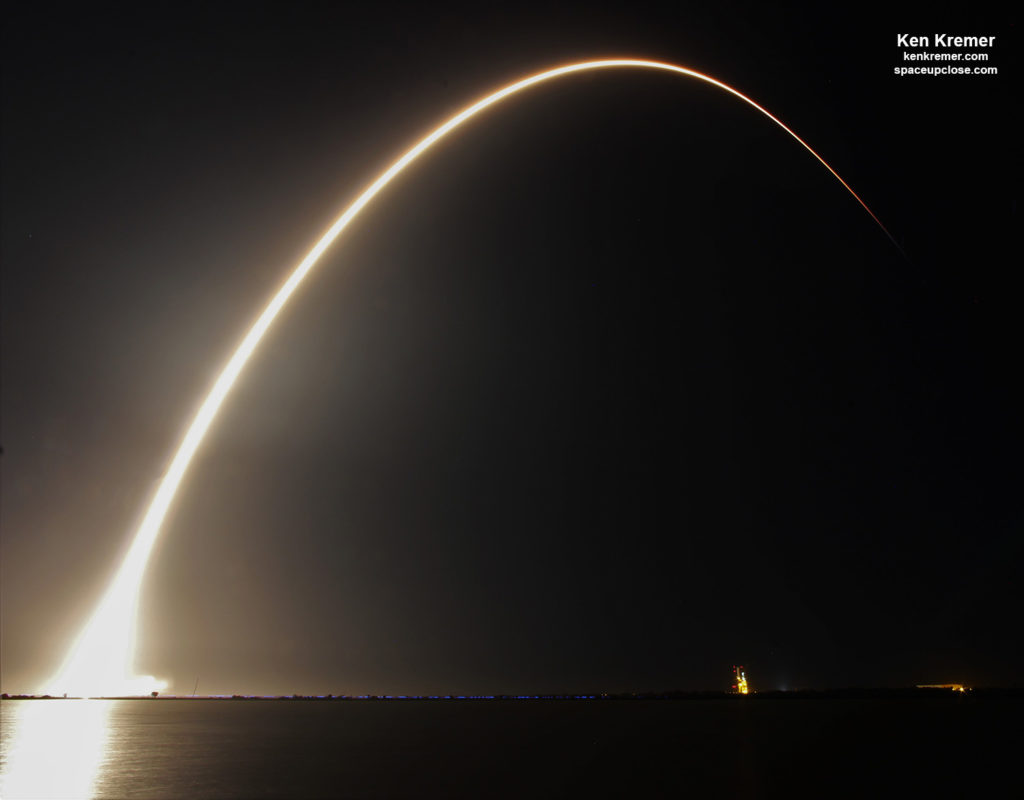 |
|
Beresheet moon lander mission timeline and trajectory. Credit:
Space IL |
Ken
Kremer — SpaceUpClose.com &
RocketSTEM — 19 March 2019
CAPE CANAVERAL, FL – Isreal’s first moon mission the privately
funded ‘Beresheet’ lunar lander is on course for Destination Moon and capture into
lunar orbit following a successful one minute long thruster firing of the main
engine this morning, Tuesday, March 19.
A 60-second-long orbit raising firing of the private
probes 100-pound-thrust main engine was
carried out successfully at 8:30 a.m. EDT (1230 GMT, 230
p.m. Israeli time) Tuesday, March 19, as the ship remains healthy and in communication
with mission control, according to the mission team led by SpaceIL and Israel Aerospace Industries (IAI).
The thruster firing extended the spacecraft’s highly
elliptical orbit around the Earth to an altitude or apogee of more than 250,000
miles (405,000 kilometers), officials with the mission
announced this afternoon.
Lunar gravitational capture of Beresheet is
expected on April 4.
If all goes
well lunar touchdown is scheduled for April 11 at Mare Serenitatis (Sea of
Serenity) on
the Moon’s northern hemisphere.
“Beresheet is now in an
elliptical orbit where it is expected to leave Earth’s orbit and join the
moon’s orbit at 405,000 km (251,655 miles) from Earth,” the team announced.
“The spacecraft’s systems
are functioning as expected, and it is communicating with the IAI and
SpaceIL control room in Yehud, Israel”.
The Beresheet lunar lander is a joint endeavor
funded and built by Israeli nonprofit SpaceIL and Israel Aerospace Industries
(IAI). It marks Israel’s first lunar mission and also counts as being the
world’s first privately funded lunar mission.
 |
|
Beresheet
lunar lander provided by Israeli nonprofit SpaceIL and Israel Aerospace Industries (IAI) for launch on SpaceX Falcon 9 on Feb 21, 2019. Credit Space IL/IAI |
Today’s maneuver marked the last major firing
of the main engine.
A few much smaller trajectory adjustment
firings are still planned by the engineering teams. These will optimize the
spacecraft’s trajectory for lunar capture in about two weeks, says Opher Doron, IAI Space Division General Manager.
“We are on the way to
the moon very successfully right now,” Doron said in a post thruster firing maneuver
briefing update today.
“That’s enough to reach the distance of the
moon from the Earth, and it’s actually our last maneuver to get closer to the
moon. We will have a couple of more
maneuvers over the following days that are small maneuvers to slightly adjust
our trajectory, we are on our way to the moon very successfully right now.”
Thereafter
the team will command multiple orbit lowering burns to send Beresheet spiraling
down to the moon and eventually a hoped for soft landing.
Doron explained the team was
able to overcome problems with the probes star trackers that have not worked as
expected.
“We’ve learned to deal
with the difficulties we’ve been having with the star trackers, and what that
entails in maneuvering the spacecraft in a non-nominal fashion.”
The team was able to
monitor the firing in real time.
“So that was working quite well today. We were
lucky to have the engine firing in a communications pass. We actually saw it in
real-time.”
Altogether Beresheet has been commanded to
conduct four orbit raising thruster firings.
A computer glitch on Feb 25 forced
cancellation of the second planned orbit raising thruster firing maneuver as it
continued on its current orbit to reach the Moon. Eventually that 2nd engine firing
was completed on Feb 28 following by a third one on March 7.
Liftoff
of the private
Beresheet moon lander for Israel atop a recycled SpaceX Falcon 9 rocket took place in the
evening of Feb.
21 at 8:45 p.m. EST (0145 GMT Friday) from Space
Launch Complex-40 on Cape Canaveral Air Force Station, FL. It flew as a rideshare
payload bolted to the primary payload – namely the Nusantara Satu communications
satellite for Indonesia
landed on the Moon- the US, Russia and China and those were all government run
missions.
million as the world’s first privately funded and developed moon lander.
Beresheet, which in
Hebrew means “genesis” or “in the beginning” was one of the competitors for the
now defunct Google Lunar XPrize.
The Falcon 9 launch propelled Beresheet onto the proper
trajectory to begin a series of 4 elongating long looping orbits to gradually
reach the moon.
The four landing legs were deployed as planned soon after
launch.
If successful it will
be the smallest spacecraft to ever land on the Moon, at only 1,322 lbs, or 600
kgs, fueled. The probe has an unfueled mass of 180 kg.
 |
|
Selfie snapped by Beresheet spacecrafts on
board camera shows the lander, Earth and Israeli flag at a distance of 23,000 miles (37,000 kilometers). Credit: SpaceIL/IAI |
Beresheet is traveling to the
Moon using its own power and thruster after launching as a rideshare
payload.
Overall the voyage takes
about two months over several expanding
elliptical orbits – for the longest ever trip to Earth’s nearest neighbor covering a total distance of 6.5 million km.
It will transmit panoramic photos
and video from the lunar surface and conduct scientific measurements with a
magnetometer and laser retroreflector from NASA. Also onboard is an Israeli flag, a time capsule, and a lunar library.
Beresheet has a lifetime of about 2 days. There
is no thermal control. The team hopes to make it hop about 500 meters before it
dies.
The moon probe measures 2.3 meters (7.5 ft) in
diameter and 1.5 meters (4.9 feet) in height.
Watch my post thruster maneuver interview on i24 Isreali TV News
on March 19 here:
Watch my post launch
interview on i24 Isreali TV News here:
 |
|
Dr. Ken Kremer/Space UpClose interviewed by I24
anchor Michelle Makori during Beresheet mission launch on SpaceX Falcon 9 from Cape Canaveral Air Force Station Feb 21, 2019 |
Fox 35 Orlando interviewed me about the Nusantara Satu/Beresheet moon lander launch and Mr. Steven’s arrival and fairing recovery
goals. http://www.fox35orlando.com/news/local-news/spacex-plans-falcon-9-rocket-launch-for-thursday
launched Beresheet and then safely touched down on the OCISLY droneship at sea
arrived into Port Canaveral by tugboat Sunday morning, Feb 24, just 2.5 days
after blastoff. Read my story photos
here.
Watch for Ken’s
continuing onsite coverage of NASA, SpaceX, ULA, Boeing, Lockheed Martin,
Northrop Grumman and more space and mission reports direct from the Kennedy
Space Center, Cape Canaveral Air Force Station, Florida and Wallops Flight
Facility, Virginia.
Stay tuned here for Ken’s continuing Earth and
Planetary science and human spaceflight news: www.kenkremer.com –www.spaceupclose.com – twitter
@ken_kremer – email: ken at kenkremer.com
Dr. Kremer is a research scientist and journalist based in the
KSC area, active in outreach and interviewed regularly on TV and radio about
space topics.
Ken’s photos are for sale and he is available for lectures and outreach events
upcoming talks:
“Exploring Mars; The Search for Life & A Journey in 3-D.” 7 PM, Lawton C
Johnson Middle School, Summit, NJ:
https://www.eventbrite.com/e/sef-grant-presents-exploring-mars-and-the-search-for-life-3d-registration-55524445110




